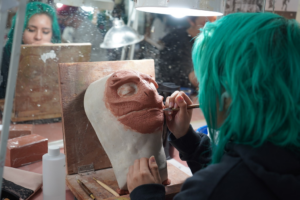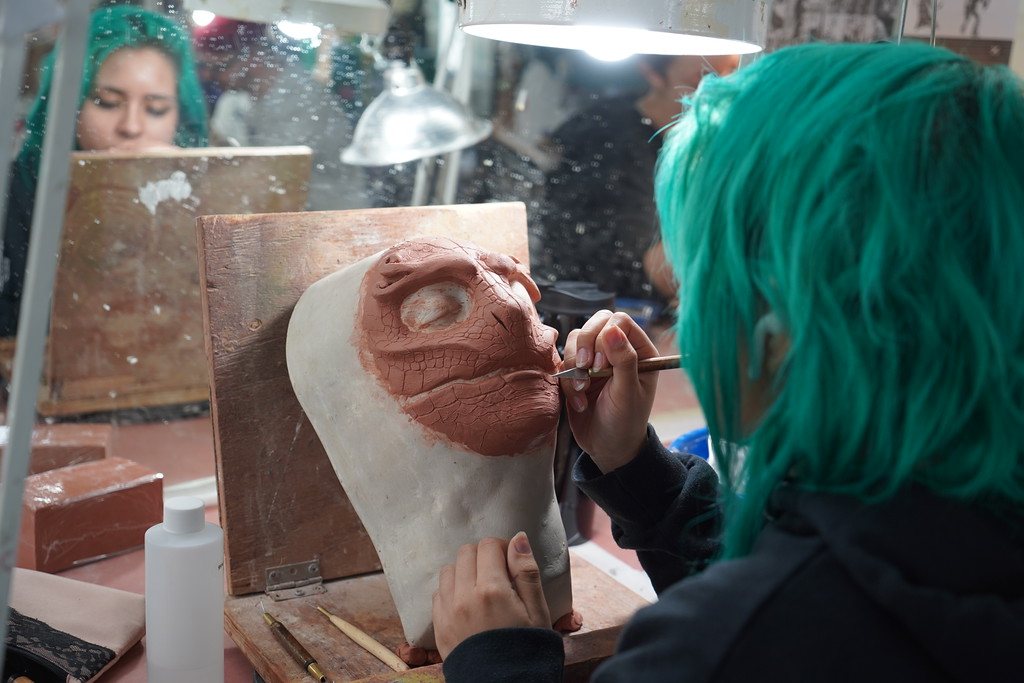Special effects makeup has the power to transport audiences to new places, bring creatures to life and create stunning transformations that look incredibly real. If you’re passionate about creating these amazing effects, one of the most important decisions you’ll make is choosing the right material for your prosthetics.
Two of the most popular materials in the industry are foam latex and silicone, each with unique qualities that affect how your prosthetics look, feel and perform. Understanding the differences between these materials will give you the confidence to select the perfect material for your next project.
This guide is designed for artists at all skill levels who want to learn more about the strengths and challenges of these materials. You’ll find useful tips on making and applying prosthetics, so keep reading to find out which option suits your creative vision best.
What Are SFX Prosthetics?
Before diving into material comparisons, let’s clarify what SFX prosthetics are.
These are appliances created to alter an actor’s appearance. Prosthetics can simulate wounds, scars, aging, fantastical creatures, or completely transform someone into an alien or monster. They are sculpted, molded and then cast using materials like foam latex or silicone.
The material choice affects not only how the prosthetic looks but also how it moves, feels and lasts on camera or stage.

Foam Latex Prosthetics
Foam latex prosthetics have been a staple of special effects makeup for decades. Made by whipping latex into a foam and baking it in a mold, foam latex results in a lightweight, flexible material that is ideal for large prosthetic pieces.
Key Benefits of Foam Latex Prosthetics:
- Lightweight and breathable: Foam latex is porous, allowing air to pass through. This breathability helps actors remain comfortable during long shoots or performances.
- Flexible and stretchy: It moves naturally with facial expressions, making it ideal for creature masks and other large prosthetics.
- Cost-effective: Foam latex is generally less expensive than silicone, making it popular for productions with budget constraints.
- Easy to paint: It accepts paints and adhesives well, allowing for realistic finishes.
Smart Suggestion: Use KY Jelly to add realistic shine to foam latex appliances like tears or sweat for that extra lifelike touch.
Silicone Prosthetics
Silicone prosthetics have become increasingly popular, thanks to their camera-ready realism in today’s high-definition productions.
Advantages of Silicone Prosthetics:
- Unmatched realism: Silicone mimics the look and feel of real skin better than foam latex. It has a natural translucency and soft texture.
- Durability: Silicone is tougher and resists tearing better than foam latex, making it ideal for repeated use.
- Self-adhesive properties: Many silicone prosthetics bond directly to the skin without requiring additional glue.
- Water-resistant: Unlike foam latex, silicone prosthetics can withstand moisture and sweat without degrading.
Helpful Hint: Use 3rd Degree Silicone to achieve high-quality, skin-like prosthetics that hold up well over time.
Foam Latex vs Silicone
Let’s break down the unique strengths of foam latex and silicone in SFX makeup.
| Feature | Foam Latex | Silicone |
|---|---|---|
| Weight | Lightweight | Heavier |
| Flexibility | High | Moderate |
| Breathability | Very breathable | Not breathable |
| Realism | Moderate | High |
| Durability | Moderate | High |
| Cost | Lower | Higher |
| Application | Requires adhesives | Some are self-adhesive |
| Maintenance | Absorbs oils, requires care | More resistant to sweat and oils |
| Ideal Use | Large creature masks, theater | Close-up realistic wounds, facial appliances |
How to Make SFX Prosthetics: A Quick Overview
Making SFX prosthetics involves sculpting, molding, casting and painting to create lifelike pieces, followed by proper application techniques for a seamless finish. Here’s a quick breakdown of the essential steps involved:
- Sculpting: Start by sculpting the desired prosthetic shape using clay.
- Molding: Create a mold from the sculpture, usually in plaster or silicone.
- Casting: Fill your mold with foam latex or silicone and allow it to set fully.
- Demolding: Remove the finished prosthetic carefully.
- Painting: Use special paints designed for foam latex or silicone to bring your piece to life.
- Application: Attach the prosthetic to the actor’s skin using adhesives, blending edges for a seamless look.
Must-Read Articles on SFX Makeup:
How 3D Printed Prosthetics Are Revolutionizing Movie Makeup?
How Cinema Makeup School’s Bootcamps and Workshops Empower You to Master SFX Makeup?
How to Create Realistic Wounds and Scars with Prosthetics?
How to Apply SFX Prosthetics?
Application techniques can differ based on the prosthetic material:
Foam latex prosthetics require strong adhesives like pros-aide or spirit gum. Once applied, edges are carefully blended with liquid latex and makeup.
Silicone prosthetics often use medical-grade adhesives or are self-adhesive. Silicone paints or powders are used to match skin tones and add realism.
Insider Advice:
If you are wondering where to learn special effects makeup to create perfect prosthetics, look no further than Cinema Makeup School.
Here, you’ll learn from industry experts with hands-on experience in film, television and entertainment. As a proud part of the Cinema Art College Corporation, we’re committed to helping you develop real, career-ready skills.
We offer financing options to support your goals and make advanced education more accessible.
Our reputation continues to grow internationally. Learners from Korea’s MBC Academy Beauty School come to us for expert-level SFX training, showcasing our commitment to top-tier education
New to SFX Prosthetic Makeup? Start with These Expert Tips
- Start with foam latex prosthetic makeup if you are new to SFX prosthetics – it’s more forgiving and budget-friendly.
- Focus on sculpting anatomy and texture; a well-sculpted design is the foundation of a realistic prosthetic.

- Learn the casting process for both foam latex and silicone, as each requires different handling and curing techniques.
- Use material-specific paints – foam latex accepts PAX and alcohol-based paints; silicone needs silicone-based pigments.
- Master the art of seam blending to hide edges and make prosthetics look natural on the skin.
- Always prep the skin properly before applying prosthetics using the correct adhesives for each material.
- Clean and store prosthetics safely – foam latex needs dry, cool storage and silicone should be kept flat and dust-free.
- Build your starter kit gradually, investing in essential tools and products as your skills grow.
- Take photos of your work at every stage to track progress and build a portfolio.
- Watch professional tutorials and behind-the-scenes content to learn industry techniques and best practices.
- Be patient, practice regularly, accept mistakes and stay motivated to improve with each new piece.
Foam latex or silicone – each material has its own magic. Know your materials, master your craft and watch your SFX prosthetics come alive like never before!
Enroll today to take your passion for special effects makeup to the next level!


























































